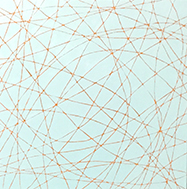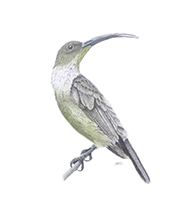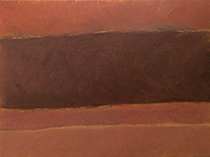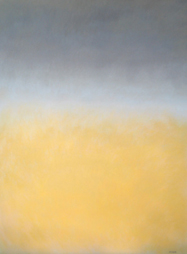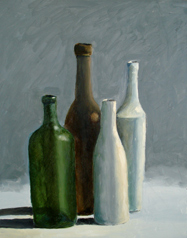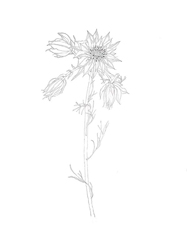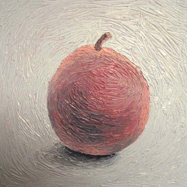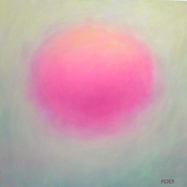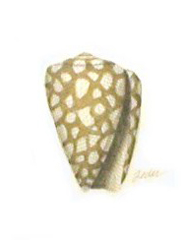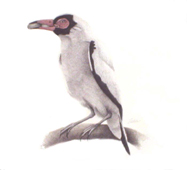While traveling to Puerto Vallarta, Mexico on an artist retreat I had a few insights about my personal life. I became more aware of the complexity of my relationships with family, friends and peers and how they can be much like entangled webs, whether easy or burdensome. What also came mind was a particular artist’s paintings of cobwebs and my past pen drawings of birds. I can’t help to wonder how these constellations worked in unison to help me embark on my next series of works. Once I left the retreat I began to refine my basic compositions of lines. These images started to form intricate webs that had intersections reminiscent of stars. My new paintings almost appear like elegant lace work, yet have a deeper meaning other then a beautiful tapestry. I think they represent the energy we tackle within our minds and some of it like the static currents in the universe.
In conjunction with my paintings, I started drawing birds again and found them to be frail, little, precious beings. They worked their way back into my life. When I was in Mexico I loved the tunes of the many birds tucked away on the hillside. Even now, I leave my windows open in my home to bring the sounds of those beautiful creatures indoors. These crosshatching drawings have the same intensity the abstracts have, but on a minuscule scale. The drawings are tightly woven and display a sort of grace that I see in the abstracts too. Even though the techniques are two different entities they compliment one another very much. With these pieces I feel I’ve come full circle in my creative lessons.
My work is a product of inner growth, just a mere artifact of life. It is also a catalogue of the emotional discovery over many years. I’ve come to realize that it is not only a study of technique and medium, but also a study of self. When viewing my work from a far I see how tightly woven my thoughts and personality are, and how they fester into obsessive works of art. I have discovered that this aspect of my character is cemented most permanently; I have come to terms that the personality is only flexible to a certain degree. I am forever fastidious and somewhat rigid. But, with that said I have begun to notice the soft subtleties and grey areas of life; the fascinating wonders missed due to polarized thinking.
It is difficult to completely understand the different aspects of your-self; there are the many considerations of personality, environment, DNA, society and so forth. These different components need to be dissected to find order. For me, art has been a catalyst, in this process, and a tool to identify the kaleidoscope of character. Art has also, aided in this exploration, it is undeniably and instrumentally important in finding those hidden valleys of emotions and thoughts. Abstract shapes and color reflect the newly defined and segmented areas of self- awareness, the reorganization, which has taken place over the years. I can see myself with much clarity now. And, the more enlightened I become the richer and deeper my colors miraculously appear. These new paintings represent the offspring of the many parts of my psyche.
I’m an abstract expressionist artist. I approach my canvases by delving into the subconscious, which is the beginning of an abstract work of art. There is no treading on light ground or the superficial, once a brush touches the canvas a world of emotions unravel, and with great effort. Sometimes the paint flows naturally and easily, but there are those moments of difficulty and frustration. When there are no objects to look at nor their tangibility to abide by, the task of art making becomes challenging. The relationship is complex, much like a marriage. There are those intermittent days that I have to look beyond the surface of the marriage to evolve through time. This is what happens with abstract expressionism, the work moves over a period of time and builds upon a fundamental infrastructure. And there are the moments of contact and connection with the subconscious that sometimes come fleetly or last long periods of time.
After being conditioned to realism for over a period of fifteen years, I realized I was only treading the surface of life, but with abstract expressionism I’m able to touch the core of my soul, which was once found and trapped in tangible objects. I was tied to the affinity of my own outer-shell. The transition from realism to abstract works was a defying moment in my career and also my own personal growth. It required many sessions of self- discovery to lead up to the ultimate bliss of knowing my subconscious. I didn’t think such feelings of profound complexity would ever surface in my work. So concentrated and buried were my emotions that my soul burst upon arrival of layers in-between layers of paint. At one point these layers of emotions lay hidden until I became bored with my own superfluous habits – day in and day out. I still have the old habit of running on an infinite wheel, but since I have worked with abstract paintings a new persona comes forth. It shows it’s self with much pride and exuberance.
I worked along side artist Greg Gandy who introduced me to classical painting. At that time I worked and lived in San Francisco.
The image above is an example of a line drawing drafted in graphite - the lead is of medium density. I’ve chosen this medium to express the tender-delicate side to life. I have found flowers to be a source of interest due to much time-spent gardening. I began arranging flowers, picked from the garden when spring had just begun; in due course, with much enthusiasm, I noticed the various lengths of longevity among the many varieties of cut flowers placed about the house. I began to wonder what it would take to extend the life of a flower. In order to have a longer lasting bouquet they would need to be attended to carefully, but what would be needed? There are many factors to consider with the life span of a cut flower, since they are no longer receiving the nourishment from the soil cut flowers should have clear- nutritious water at all times and be in cool temperatures – this will help keep a flower longer. Also, there are the old homegrown remedies that have been passed down from generation to generation to maintain a healthy bouquet. I’ve provided some of these remedies in the latter under “tips & home remedies”. Another factor to consider is a flower from hybrids, which usually come from a long line of descendents. With years and years of propagation the original flower looses its robustness - clearly the heirloom flower is especially resilient. As well, placing indigenous flowers in their right environment will outlast an extraneous flower unfamiliar to its habitat or climate. Bouquets purchased at your run-of-the-mill grocery store probably have very few indigenous flowers to your area. Fresh homegrown flowers can be found either at a farmers market or meandering around a field or any wildlife habitat – they are in conditions where they were breed and respond to the idiosyncrasies of their surroundings.
I spent days in the garden observing buds blossom then gradually arrive to their ultimate finale – there are many subtleties that occur before a flowers eventual collapse. This insight is the passing of life, not only in the garden but also within ourselves. One begins to appreciate the life span, conditions and needs of these frail objects. I’ve watched flowers bud and decay in several different conditions and confines. Nature’s clock has allotted each blossom to bloom for: days, weeks or even months. Then there is the cycle of life spawned by the warmth of spring and the eventual hibernation or even death that gives way to winter. I can only turn my thoughts to how delicate life can be, – the everlasting cycle, the turning over with each season. I’ve begun to draft the first cut of a fresh bud to its ultimate conclusion. The three images above are samples of different stages of a flower lived, within a three-week period. I plan to create many stages to show the slow or even quick changes, the dates that they are drawn and the temperature of that day. This sounds sort of like a cataloguing of life, in some sense it has become this – there is the fine line of beauty and science that lies within a flower’s being, there is a splendor that lies within the many stages of existence, which prove to be as captivating as the next - recognizing life itself.
Tips & home remedies
The stem of the flower that will be in water should have all its leaves pealed away – this is to prevent water from molding over time and flowers absorbing bad water; cut flower ends at an angle to give the ends ample surface to absorb water & food; one crushed Aspirin dissolved in water has been suggested to prolong the healing process of the stems cut ends - this allows the stem to absorb food and water for a longer period of time; sugar for food – use a splash of nectar used for hummingbird feeders; if handy use bottled spring water; change the water when it becomes cloudy; keep most flower displays in a cool and semi-lit areas in your home – heat or direct sunlight will only speed up the burgeoning process; place tired flowers in a cold bath over night or simply place the vase in a refrigerator for the night; Home Recipe: 2 tablespoons of lemon juice, 1 tablespoon of sugar to 4 cups of water, 1/2 teaspoon of bleach - flowers will stay fresh.
Abstract forms were my main concentration during the last few years, until recently when I came to an abrupt halt. During much personal change in the last year pulled me away from abstract expressionism. No longer was I able to tap into my emotional- well, which abstract work requires much of. Frustrated of the liberating experience taken from me and struggling to make sense of the loss; I once again returned to realism during this lull. But over the past few months I have grown to love my works of still life painting, used with the impasto technique, which leaves a textural surface - such as the thick brush strokes seen in Van Gogh's work. As I continue on this journey of realism painting I become enamored with the idea of colorful fruits as painted forms. As I look at the simplicity of compositions, the abstract clouds come to mind; I feel they somehow still lie within my conscience. I'm happy to say I still carry them with me. I hope to tap into my emotions once again to create the soft sensual forms that describe a deeper part of myself, but during the interim I am enjoying the simplicity of still life painting and finding a different part of my humanity, which I'm not quite sure what that may be at the moment, but has been a fulfilling progression. At present I live in San Francisco with my husband and work out of my studio.
With oil painting I have created shapes of lush, lavender clouds that are superimposed on olive colored skies and golden ovoids with soft edges that blend into pale-pink backgrounds. The tranquil and slow floating forms come and go, fading in and out of sight, and then eventually work their way onto my canvas. I refer to these images as cloud abstracts.
My cloud series has been a great challenge, one that is enjoyable and at the same time an emotional whirlwind. I came from a draftsmen background and the technique I used was crosshatching with pen and ink. The change to oil painting, using the glazing technique, was an adjustment during months of painting. The two mediums are very different all together. The transition from ink to paint has been liberating, as well as difficult and tricky at times.
The evolution of simplistic forms began with realistic studies of cloud formations with oils on board and canvas. I observed the gradual changing hues of ocean panoramas and skylines, which eventually came to fruition in abstract bands. As I continued back and forth from realism to abstracts, the two processes synchronized into biomorphic spaces. The open sky began to offer images that I was not mindful of when first painting cloud formations. I searched the skies for months and finally found the simplistic shapes I so desperately desired, ovoids and spheres.
The painting technique called glazing, combined with scumbling is very delicate and allows me to implement the soft images on my canvas. The images are produced with a fanned sable brush used in a swirling motion. This process is an ideal technique for the smooth transparent spheres and elliptical forms.
Miami art collectors Marty and Cricket Taplin commissioned myself to create 175 pen and ink drawings of seashells for the majority of the suites at the Sagamore Art Hotel.
Commissioned by Miami art collector Marty Margulies on several occasions for his personal collection at Grand Bay Residences. At that time he purchased my ink drawings of birds.

